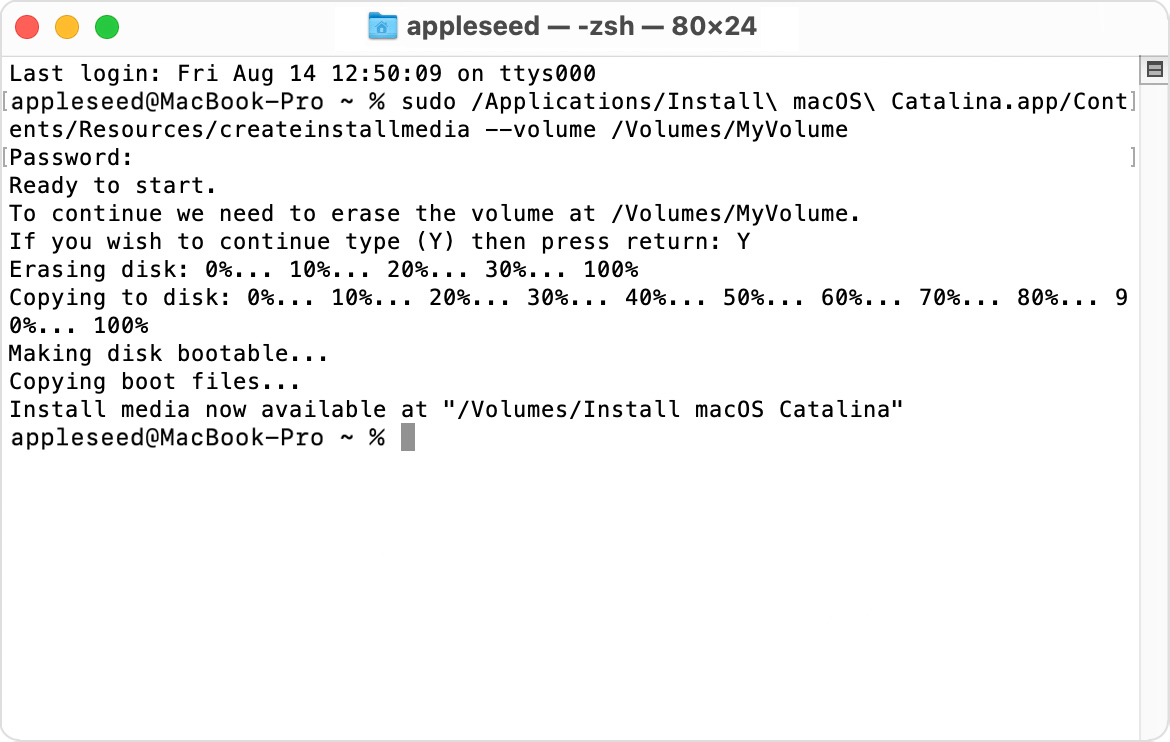Imac G5 Mac Os X Install Disc 1 Download
How to create a bootable installer for macOS
You can use an external drive or secondary volume as a startup disk from which to install the Mac operating system.
These advanced steps are primarily for organisation administrators and others who are familiar with the control line. You lot don't demand a bootable installer to upgrade macOS or reinstall macOS, but it tin be useful when you lot want to install on multiple computers without downloading the installer each time.
What y'all demand to create a bootable installer
- A USB wink drive or other secondary book formatted as Mac Bone Extended, with at least 14GB of available storage
- A downloaded installer for macOS Monterey, Big Sur, Catalina, Mojave, High Sierra, or El Capitan
Download macOS
The installer for macOS Monterey,macOS Big Sur,macOS Catalina,macOS Mojave, ormacOS Loftier Sierra downloads to your Applications folder as an app named Install macOS [version proper noun]. If the installer opens subsequently downloading, quit it without continuing installation. To get the correct installer:
- Download on a Mac that is uniform with that version of macOS.
- Download on a Mac that is using macOS Sierra 10.12.5 or later, or OS X El Capitan x.11.6.
- Enterprise administrators: Download from Apple, not a locally hosted software-update server.
The installer for OS 10 El Capitan downloads to your Downloads folder as a disk image named InstallMacOSX.dmg. To get the installer:
- Download using Safari, and open the disk image on a Mac that is compatible with Bone X El Capitan.
- Inside the disk epitome is an installer named InstallMacOSX.pkg. It installs an app named Install Os X El Capitan into your Applications folder. You will create the bootable installer from this app, not from the disk image or .pkg installer.
Use the 'createinstallmedia' command in Terminal
- Connect the USB flash bulldoze or other volume that you're using for the bootable installer.
- Open Final, which is in the Utilities folder of your Applications folder.
- Type or paste one of the following commands in Terminal. These assume that the installer is in your Applications binder, and MyVolume is the name of the USB flash drive or other book yous're using. If information technology has a dissimilar name, replace
MyVolumein these commands with the name of your volume.
Monterey:*
sudo /Applications/Install\ macOS\ Monterey.app/Contents/Resources/createinstallmedia --volume /Volumes/MyVolume
Large Sur:*
sudo /Applications/Install\ macOS\ Large\ Sur.app/Contents/Resources/createinstallmedia --book /Volumes/MyVolume
Catalina:*
sudo /Applications/Install\ macOS\ Catalina.app/Contents/Resources/createinstallmedia --volume /Volumes/MyVolume
Mojave:*
sudo /Applications/Install\ macOS\ Mojave.app/Contents/Resources/createinstallmedia --volume /Volumes/MyVolume
High Sierra:*
sudo /Applications/Install\ macOS\ High\ Sierra.app/Contents/Resources/createinstallmedia --book /Volumes/MyVolume
El Capitan:
sudo /Applications/Install\ Os\ X\ El\ Capitan.app/Contents/Resource/createinstallmedia --volume /Volumes/MyVolume --applicationpath /Applications/Install\ OS\ Ten\ El\ Capitan.app
* If your Mac is using macOS Sierra or earlier, include the--applicationpath statement and installer path, similar to the mode this is washed in the command for El Capitan.
After typing the command:
- Press Return to enter the command.
- When prompted, blazon your administrator countersign and press Render once more. Terminal doesn't prove any characters as you blazon your password.
- When prompted, type
Yto confirm that you want to erase the volume, then press Render. Concluding shows the progress as the volume is erased. - After the volume is erased, you may meet an alarm that Final would like to access files on a removable book. Click OK to allow the copy to proceed.
- When Terminal says that information technology'due south done, the volume will accept the same name every bit the installer you downloaded, such as Install macOS Monterey. You lot can at present quit Terminal and squirt the book.

Use the bootable installer
Apple tree silicon
- Plug the bootable installer into a Mac that is connected to the net and compatible with the version of macOS you're installing.
- The macOS version that came with the Mac is the primeval version it can utilize.
- A bootable installer doesn't download macOS from the internet, but it does require an internet connection to become firmware and other information specific to the Mac model.
- Plow on the Mac and continue to hold the power button until you see the startup options window, which shows your bootable volumes.
- Select the volume containing the bootable installer, then click Keep.
- When the macOS installer opens, follow the onscreen instructions.
Intel processor
- Plug the bootable installer into a Mac that is continued to the internet and uniform with the version of macOS you're installing.
- The macOS version that came with the Mac is the earliest version it can use.
- A bootable installer doesn't download macOS from the internet, but information technology does require an internet connection to get firmware and other information specific to the Mac model.
- Printing and hold the Option (Alt) ⌥ key immediately after turning on or restarting the Mac.
- Release the Option key when you run across a dark screen showing your bootable volumes.
- Select the book containing the bootable installer. Then click the upwards pointer or printing Return.
If you lot can't beginning upwardly from the bootable installer, make sure that Startup Security Utility is set to allow booting from external or removable media. - Choose your language, if prompted.
- Select Install macOS (or Install Os Ten) from the Utilities window, and so click Continue and follow the onscreen instructions.
Learn more than
For information about the createinstallmedia command and the arguments y'all can utilize with it, brand sure that the macOS installer is in your Applications folder, and so enter the appropriate path in Terminal:
/Applications/Install\ macOS\ Monterey.app/Contents/Resource/createinstallmedia
/Applications/Install\ macOS\ Big\ Sur.app/Contents/Resources/createinstallmedia
/Applications/Install\ macOS\ Catalina.app/Contents/Resources/createinstallmedia
/Applications/Install\ macOS\ Mojave.app/Contents/Resource/createinstallmedia
/Applications/Install\ macOS\ Loftier\ Sierra.app/Contents/Resources/createinstallmedia
/Applications/Install\ OS\ Ten\ El\ Capitan.app/Contents/Resource/createinstallmedia
Published Date:
Imac G5 Mac Os X Install Disc 1 Download
Posted by: donovanpragnot1938.blogspot.com
Post a Comment